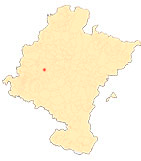La Portada de San Miguel de Estella
Introduction
The doorway of San Miguel de Estella is one of the most important sculptural ensembles of the 12th century in the Iberian Peninsula. Belonging to the late Romanesque period, it stands out for the complexity of its figurative speech , the formal quality of the reliefs and the wise composition that leads the viewer's gaze towards the most significant scenes.
The prosperity of Estella, a town linked from its origins to the Pilgrim's Way to Santiago, led to the foundation of several parishes in the twelfth century, among which San Miguel stands out with its three naves, its large transept, its monumental apse with stepped apses and, especially, its main doorway which, due to the peculiar orography of the district, opens towards the north, towards the place where the old market was held. There it was contemplated by the parishioners and by those who came to the market, among whom were probably pilgrims on their way to Santiago de Compostela, although this would not be the most common public.
The stylistic similarities between the doorway and certain capitals of the windows of the central apse lead us to believe that the creation of an exceptional entrance was planned from the very beginning of the church. The architectural ambition coincides with the sculptural display, charged with theological content in accordance with the concerns of the time. It has not been possible to find out who was behind the undertaking, either financially or doctrinally. We also know almost nothing about the sculptors, the best of whom belonged to a renovating trend capable of fusing Byzantinism with solutions from the North of France.
The granting of privileges to some of the inhabitants in 1187 attests to the vitality of the district, but does not provide any specific clues as to when the doorway was made. It is the comparative analysis with contemporary sculptural productions, both from Navarre and from other Hispanic and French kingdoms, which supports a date in the last third of the 12th century, perhaps around 1170-1190, a period in which the moderate strength of the kingdom of Navarre coincided with the reception in the Iberian Peninsula of the Oriental and ultra-Pyrenean artistic forms already mentioned.











